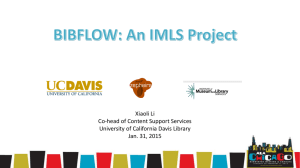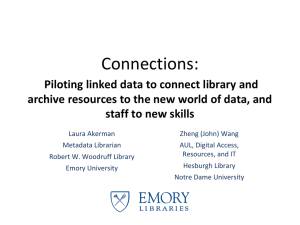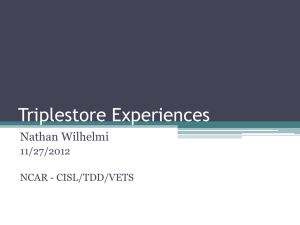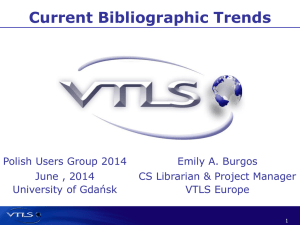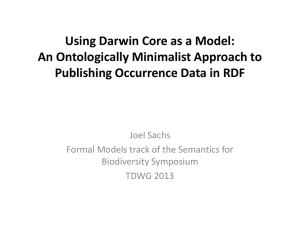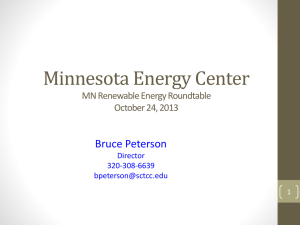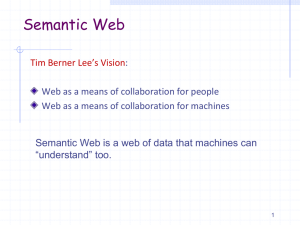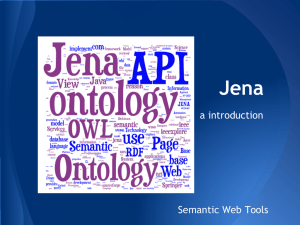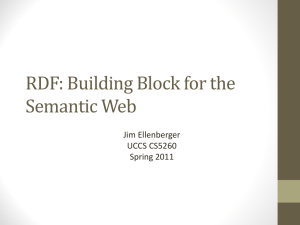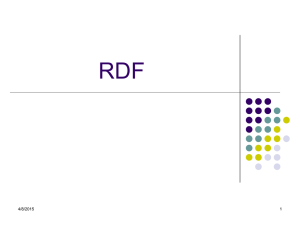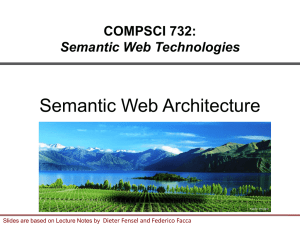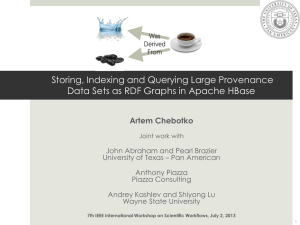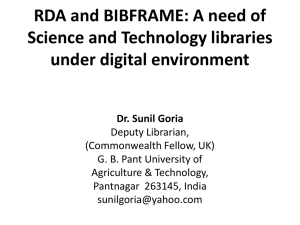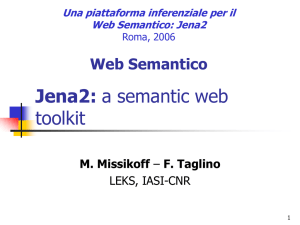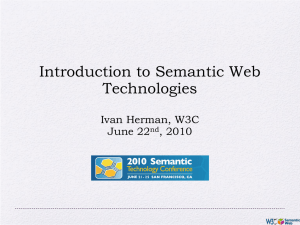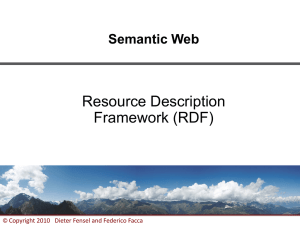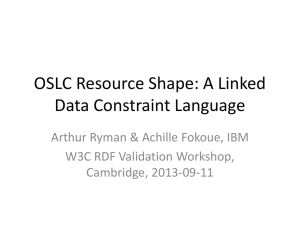BIBFRAME - Describe NZ
advertisement
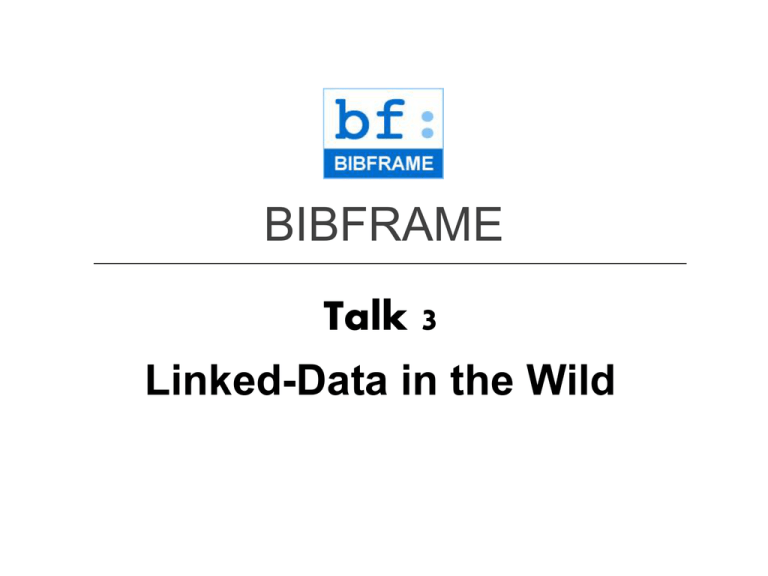
BIBFRAME Talk 3 Linked-Data in the Wild Talk 3 Part 1 Resource Description Framework (RDF) and its structure: from MARC to BIBFRAME Main points from Talk 1 + Talk 2 • BIBFRAME is an initiative and intellectual framework which will likely replace MARC as the foundation for data-exchange and informationsharing of bibliographic information • Other data Linked Open Data (LOD) is made possible Resource Description Framework (RDF). RDF is a framework for describing Web resources, which is anything that can be retrieved or identified on the Web via a Uniform Resource Identifier (URI) • The BIBFRAME model works well across the Web and allows users to find resources in library catalogues around the world, but is still under construction • The BIBFRAME model will enable us to use RDA as it was intended to be used. It’s part of LOD and learning about BIBFRAME will give you not only the tools but the skills to adapt in the future. BIBFRAME model The model uses “works” and “instances” as its basis. The model also uses “authorities” and “annotation” to describe RDA Works, Expressions, Manifestations and items (WEMI). BIBFRAME model In Talk 2, we saw MacBeth staged as a conceptual model of LOD. Specifically, MacBeth was converted to “triples” Shakespeare -> isCreatorOf -> MacBeth Triples are an efficient way to represent information because triples give exact meaning to what they describe, like a sentence in natural language. Therefore, triples work both ways and have reciprocal relationships. MacBeth -> hasCreator -> Shakespeare How a RDF triple works Each RDF-triple is a statement that has three parts. Multiple RDF triples = graph Using these three simple statements, let's turn this into a RDF graph: -Bengie is a dog. -Bonnie is a cat. -Bengie and Bonnie are friends. Now machines can read! The difference between mark-up and LOD is the addition of meaning to data. Who is using LOD/RDF today? Linked Open Data has been used for some time. It is being used on news websites, by universities by national libraries in the UK, Spain, the US, Germany, Sweden and many other institutions. Why should libraries use it? 1. 2. 3. Increasing viability and acceptance of interoperating with data from outside of libraries; RDA gives us an opportunity to fundamentally rethink some features of our data; Semantic Web activities have been given new life with the grassroots Linked Data movement. Source: DLP Brown Bag Series, 2010 RDF incorporates data from other sources? Yes, right now! BBC Wildlife Finder <http://www.bbc.co.uk/wildlifefinder/> Slide by Thomas Baker, “What Makes the Linked Data Approach Different,” NISO DCMI Webinar 2010. <http://dublincore.org/resources/training/ NISO_Webinar_20100825/dcmi-webinar-02.pdf> With LOD, records are resources computers can share Uniquie Resource Identifier (URI) For people who read German And for all those literate machines out there, there are different “dialects”! The path to Linked Open Data Finally, when libraries and other institutions make their data available, they meet the 5-star criteria. Talk 3 Part 2 BIBFRAME allows libraries to leverage LOD Useful Web / RDF definitions 1 • HTTP content negotiation: process for delivering content (data) in different formats (e.g. RDF, XML, HTML) based on HTTP requests. Useful Web / RDF definitions 2 Triplestore: a database for storing RDF data; this is needed for linked data. Useful Web / RDF definitions 3 RDF vocabularies and ontologies define categories of things and their relationships with each other. Dublin Core is a good example of a standard web ontology. URI: http://purl.org/dc/elements/1.1/creator Label: Creator Definition: An entity primarily responsible for making the resource. Type of Term: Property In other words, they are controlled vocabularies for the Web! Useful Web / RDF definitions 4 RDFS (the RDF Schema) : a basic vocabulary for ontology development • RDFS defines RDF classes and properites Class: a category of resource; a resource in such a category is said to be an instance of the class. Property: a relation between a subject and object in a triple Schemas provide a framework to make Web vocabularies more accessible to humans and machines. Source: http://www.dlib.indiana.edu/education/ Source: https://schema.org/ Linked Data on show Now you know three important things about Linked Data on the Web. 1. What RDF triples are (groups of 3-part datasets relating a resource to another) and multiple triples are called graphs; 2. How triples are organised and defined (using web vocabularies); 3. How these data are transmitted (via Web pages as HTTP requests) from triplestores (databases for data in triples-form) using precordinated rules (web Schemas). PRACTICAL APPLICATION You are now ready to see Linked Data in action using BIBFRAME. First we will examine “The Master and Margarita” by Mikhail Bulgakov in MARC. We will examine just the creator, title and Authorised Access Point for brevity. The we will reconstruct it in BIBFRAME. The Master and Margarita in OPAC at LC Other “dialects” Now the BIBFRAME view at LC MARC 010 LCCN used to build the “permalink” Here is the MARC version of the bibliographic record for The Master and A typical bibliographic record in AACR2 Margarita Note Bulgakov’s name authority number. BIBFRAME Vocabulary 1 • Available at: http://bibframe.org/vocab-list/ For example, creator looks like this: creator bf:creator Generalized creative responsibility role. Label: Creator role Type: rdf:Property SubProperty Of: bf:agent • The vocabulary terms can be used like MARC fields. BIBFRAME Vocabulary 2 Title looks like this: bf:title • Word, character, or group of words and/or characters that is a name given to a resource Title information relating to a resource: title proper, translated title, or variant form of title. Label: Title Entity SubClass Of: bf:Resource See also: http://www.loc.gov/bibframe/docs/vocab-conventions.html Linking directly to the authority The previous 2 slides can be summaried as: Bulgakov’s LCCN (MARC 010) is now is now part of a URI so can be used as linked data. We won’t need to input this kind of information directly ourselves. Spot other URIs. <bf:Work> <bf:title>Master and Margarita</bf:title> <bf:creator rdf:resource=http://id.loc.gov/authorities/na mes/n79056735 /> </bf:Work> BBC Nature: the Kākāpō and RDF How the kākāpo gets to you RDF in action BBC RDFa behind the scenes Different vocabularies give the machines reference to same definition. The Web “knows” what sort of page this is and expects RDF because of the DTD. RDF and the Kākāpo (cont.) Google search: we find not only the RDF-version of the BBC article (not the HTML version!), but also id.loc.gov authorities BBC and the kākāpo (cont.) BIBFRAME transformation & more BIBFRAME is a model for conveying, formatting and displaying bibliographic information. Even though it’s not finished yet, we can have a look right now at the BIBFRAME website. Audience input and questions are welcome. Thank you very much. This concludes the BIBFRAME series
